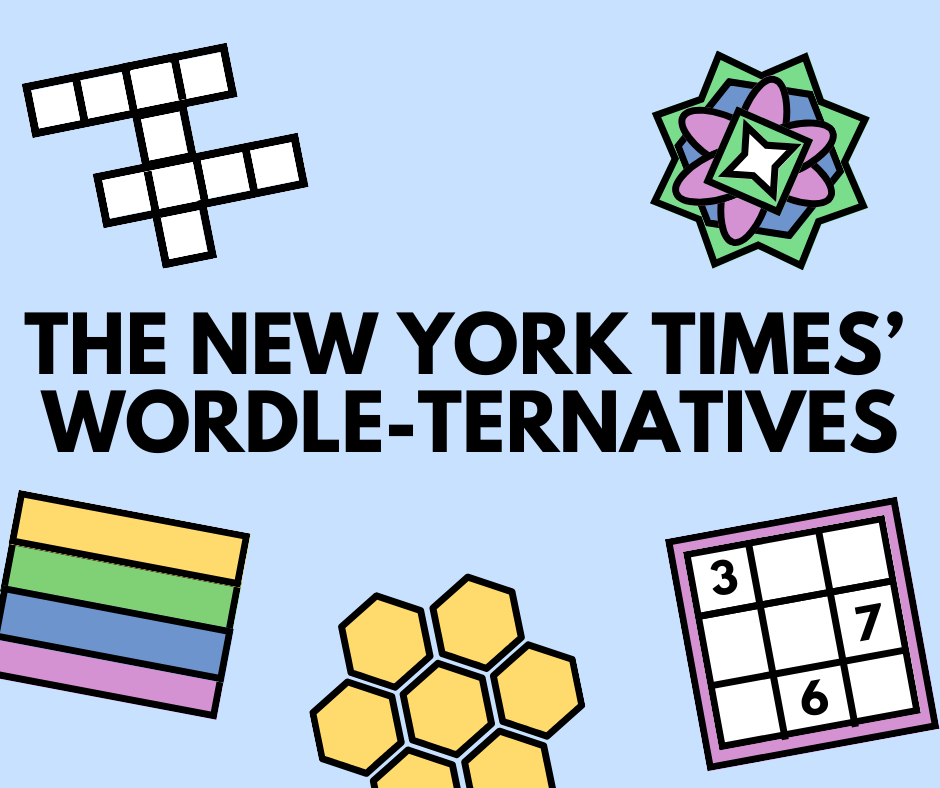In addition to Wordle, The New York Times offers many other accessible puzzles and brain teasers to challenge one’s mind each day.
“I think it’s awesome the kids are playing,” AP World History teacher Mrs. Povletich explained. “I think it’s great because they challenge the brain, they challenge us to think differently and anything that does that is not a bad thing. It’s good the students are doing that.”
Here are just some of the many Wordle-ternatives:
Connections
Connections is one of the newest games that has quickly gained popularity on the website. The categorizing game, created by Wyna Liu, deals with the process of grouping terms that share a common theme. Each board begins with a four-by-four grid and requires each player to classify the sixteen terms in groups of four with up to four guesses.
Senior Jana Lam, a frequent player of all The New York Times games described their favorite aspects of Connections: ”I personally love Connections more than the others because it requires you to know about the words, rather than just knowing of or guessing a word.”
Although the instructions may be straightforward, the game continues to challenge its players with quirky subjects and words that have multiple meanings. As a result, categorizing a certain theme may apply to more than four words, simply because the term can be placed in multiple categories. In addition, each group is color-coded based on complication. Once successfully organizing a set of terms, the boxes will change to the corresponding difficulty level: yellow is the easiest, green is medium, blue is difficult and purple is the most challenging.
“Connections incorporates pop culture and makes you think about words in a new way. It’s especially fun when I can find an interest of mine being used as a word within the game,” Lam added.
Spelling Bee
For players who enjoy word games, Spelling Bee uniquely incorporates spelling and word building into its gameplay. When starting the game, the player is presented with a honeycomb containing seven letters. In the middle lies the letter of the day that must be included in each word created from the set of letters provided.
The objective of this Wordle-ternative is to find as many words as possible while utilizing the seven letters. The assortment of letters updates every day, keeping its players busy as bees.
Unlike Wordle, Spelling Bee accepts words with four letters or more. Each word that is submitted is equivalent to a certain number of points. As more words are identified, the player ascends the ranks. Unlike other brain games, the satisfying daily puzzle promises to challenge the vocabulary of its player.
Sudoku
Originating in Japan, Sudoku has become a staple in many American newspapers. The game involves a nine-by-nine grid containing squares that must be filled in with numbers one through nine. However, numbers can not be repeated horizontally, vertically or in the individual three-by-three squares on the board.
Sophomore Logan Hindes shared his passion for the game: “I really like Sudoku because I do a lot of math, so I like looking at numbers and stuff like that. I like harder Sudokus so that I can solve them with other people.”
For those like Hindes, who prefer puzzles with numbers, Sudoku is a great game to start the day off with. Whether the player is a beginner or an experienced solver, Sudoku’s grid of numbers offers a stimulating mathematical challenge.
Crosswords
Similar to Sudoku, The Crossword is a classic brain game that has been present in newspapers long before technology. Now, with the rise in technology, The New York Times has digitized and expanded the reach of the crossword puzzle to their global audience.
There are two crosswords available on the website: The Mini and The Crossword. For those looking for a quick solve, the mini offers a five-by-five crossword puzzle, while the Crossword is 15 by 15.
“Sometimes I do the Mini Crossword and if I am really ambitious I will do the big crossword,” Povletich mentioned.
Tiles
By far, the most aesthetically pleasing game to play on The New York Times website is a simple yet creative one: Tiles. Compared to the other applications available, Tiles offers a grid of beautifully designed boxes that share various patterns and styles. The main goal of the game is to clear the grid by matching tiles with others that have similar aspects in their design.
As a whole, the game does not require strenuous skill and knowledge prior to playing. It’s meant to be relaxing, and the lack of penalty for misclicking or making a mistake makes playing the game attractive to everyone.
The New York Times has unveiled a variety of brain-stimulating games designed for anyone seeking mental engagement. These games offer a spectrum of difficulty levels, allowing players to explore and identify their personal preferences.
“I think people in general like puzzles and like solving things. Overall, I think on campus that we have a lot of smart students in West Ranch so I think that is a big reason why people like the challenge,” Hindes said.
These games represent only some of the many available on the website. Cats, to play these games and many more visit the New York Times website.









